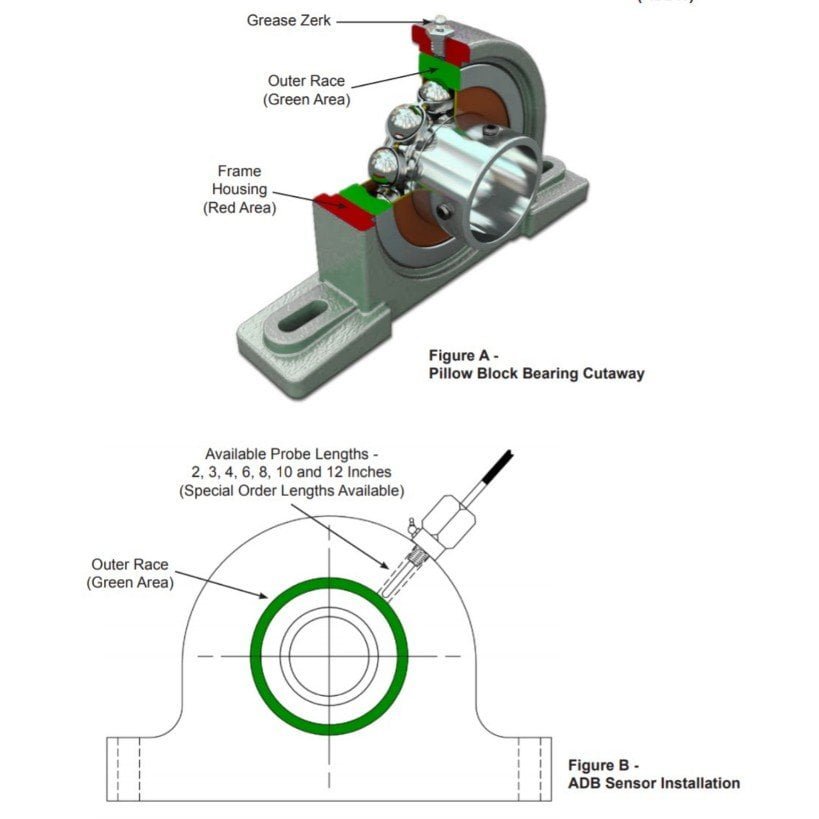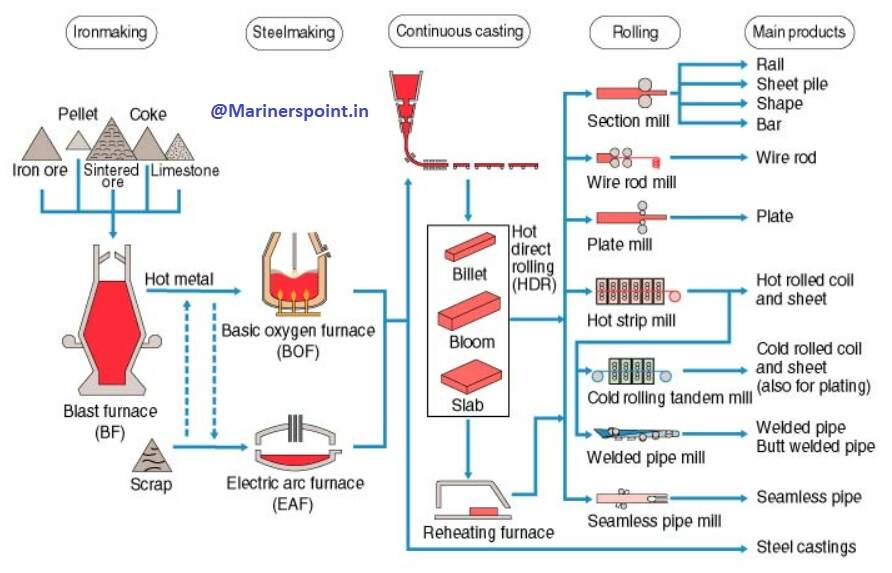Bearing Temperature Sensor / Detector
Bearing Temperature Sensor is also Known or called as Bearing Temperature Detector (BTD ).
It is Shortly known as BTD.
First ,we know about what is Temperature Sensor ?
Temperature sensor is an instrument or a device used for measuring the temperature of any things or places.
Suggest read :- Scavenge fire
Working of Temperature Sensors
As we know that temperature sensors senses temperature of any things or any places by two method either by direct contact of heating source or remotely , without direct contact of heating source with the radiated heat energy.
Indirect method of temperature sensors require two functions or variables.
Sensing elements have a repeatable resistance /voltage / current versus temperature relationship (R vs T) and operating temperature range.
The R/V/A vs T relationship is defined as the amount of resistance/voltage/current change of the sensor per degree of temperature change.
Let us in different way
Change in first function ,occurs due to radiation energy if heat source.
And this first function is directly proportional to change in temperature.
First function may be voltage, current and resistance etc.
Today, a wide range of temperature sensors, including thermocouples, resistance temperature detectors (RTDs), thermistors, infrared and semiconductor sensors, are available on the market.
Inside the temperature sensors ,For measuring temperature RTD is used which is made by a wrapping a fine wire around a ceramic or glass.
Generally,For RTD elements platinum, Copper,Nickel,or Cadmium is used and having repeatable resistance relationship versus temperature ( R vs T ) and operating temperature range.
The thermocouple is also used inside temp. Sensor and which us made up of two different materials and it did the work of generating voltage when there is change in temperature.
The voltage is directly proportional to temperature .It means when there is increase in Temperature then voltage also increased and similarly when there is decrease in temperature then voltage also decreased.
What is Bearing Temperature Sensors/ Detectors ?
Bearing Temperature Sensors or Detectors is a type of Temperature sensors which is used for measuring the temperature of Bearing.
Where Bearing Temperature Sensors / Detector located ?
As we know that bearing has mainly two parts
1.Stationary and
2.Rotary
Bearing Temperature Sensors / Detectors are installed at the stationary bearing casing and did the work of monitoring the temperature of bearings.
Bearing Temperature Installation
- Remove the existing grease zerk from the bearing housing.
- Loosen the ADB probe nut and remove the sensor probe.
- Screw the ADB sensor body in to the 1/8” NPT threaded hole in the bearing housing.
- Re-insert the temperature probe into sensor body, and adjust the probe depth to suit the bearing. For
optimum temperature monitoring, the probe should be as close to the outer race as possible without
touching (Figures A and B). - Tighten the ADB probe nut using the recommended wrench (ADBW).
The maximum recommended torque for the probe nut is 18 in lb (2 Nm). - It is important to use liquid tight flexible conduit and fittings for the
installation (Figures C and D) to protect the sensor cables.


LIQUID TIGHT FLEXIBLE CONDUIT INSTALLATION
Conduit systems can channel water directly to sensors from incorrectly sealed fittings and condensation.
Over time, water will adversely affect sensor performance. To prevent this type of damage, it is
important to properly install conduit and low point conduit drains.
Use rigid metal conduit to protect the
cables from the sensors to the control unit.
Figure C illustrates the correct installation of liquid tight flexible conduit. Notice that the bearing sensor
is above the conduit drain and the water level.
Figure D shows that water, particularly condensation, can bypass the conduit drain and flow directly into
the sensor.
SKF Bearing Sensor Unit
What is an SKF Sensor Bearing Unit ?
SKF Sensor-Bearing Units are mecha-tronic machine components covering the fields of both sensor and bearing engineering.
They are virtually an ideal combination of versatile deep groove ball bearings with sensor units shielded from external influences.
Sensor body, impulse ring and bearing are mechanically attached to each other,forming an integral ready-to-mount
SKF Sensor-Bearing Units used for
recording
● the number of revolutions
● the speed
● the direction of rotation
● the relative position/counting
● acceleration or deceleration
Apart from these bearing units with speed sensors,bearing units with temperature sensors are also from SKF.They allow immediate and permanent monitoring of bearing temperature,preventing hot-running axle boxes and bearing damage in operations.
Skf Bearing Temperature sensor
As we know that Bearing Temperature Sensors is sensor used for measuring temperature of Bearings.
SKF Bearing Temperature Sensor is also type of sensor used for measure bearing temperature.As it is made by Company SKF so it’s name SKF BTD sensors.
Generally,we use pt100 RTD sensors for measuring Bearings Temperature.
Adjustable pt100 skf Bearing sensors with grease Nipple type SKF PT100K3DN
SKF PT100K3DN has a special feature that is adjustable in the terms depth of the probe approach. This temperature sensor has been specially designed for SKF bearings.
In practice, differences of about 20% to 40% to act against surface temperature measurements. This can quickly interfere at a rise of temperature.
The PT100 delivers a permanent standby signal. If there is no such signal, the cause for this must be investigated and if possible, the PT100 sensor must be replaced.
As long as the PT100 emits a standby signal, it also emits an emergency contact signal due to its rising temperature, as soon as there is a friction that can cause harm to the machine and can cause heat, fire.
The analogue signal sensors can be connected directly to the PLC or to increase the protection of an independent monitoring device, such as the GSI48 indicator.
The analogue signal can also be converted to a digital, profibus signal by the transmitter.
Skf Bearing Temperature Limit
ATEX Classification version (Ex-i)
III 1/2 D Ex ia IIIC TX Da/Db, II 1/2 G Ex ia IIC T6..T1 Ga/Gb -40°C tot 185°C
SKF Bearing Temperature limit is 185 degree Celsius.
Bearing Temperature Sensor pt100
Bearing Temperature Sensor pt100 is a RTD sensor which used platinum for Resistance.
Pt100 is a common type of RTD sensor whose sensing elements made up of platinum.
By far,Pt 100 is the common RTD sensor used for measuring temperature of bearing which have a nominal resistance of 100 ohms at 0 degree Celsius.
Pt symbol is used for platinum and “100” is for Resistance in Ohm at 0 degree Celsius.
Similarly pt 1000 sensors ,pt for platinum and “1000” is for the resistance in ohms at 0 degree Celsius.
Resistance / Temperature relationship for metal
Typically RTD sensing elements made of platinum, copper or nickel have a repeatable resistance to temperature (R vs T) and operating temperature range.
The R vs. T relationship is defined as the sensor’s amount of resistance change per degree of temperature change.
The relative resistance change (resistance coefficient of temperature varies only slightly across the sensor’s useful range.
Bearing Temperature Sensors / Detector working principle
As we read above that temperature sensors senses temperature of any things or any places by two method either by direct contact of heating source or remotely , without direct contact of heating source with the radiated heat energy.
BTDs sense temperature without touching bearing because due to rotation there is a risk of damage of sensors.
Bearing temperature detectors working principle is that one variables connection with heating source via infrared ( Resistance,current,voltage )is directly proportional to temperature.
It uses two functions or variables
One function indirectly connection with measuring elements by infrared and second functions is temperature.
As there is change first functions of BTDs then the temperature also change.
Let us understand by example
Bearing RTD Sensor
RTD Sensor is a type of Sensor which contains a sensing element whose resistance change with change in temperature.
It is Usually made of platinum, but nickel or copper devices are not uncommon.
In today use , RTDs can take several different forms, such as wire wound, thin film.
To measure the resistance across an RTD, apply a constant current, measure the resulting voltage, and determine the resistance of RTD.
Working of RTD
The RTD consists of certain metallic elements whose resistance change is a temperature phenomenon.
A small excitation current is passed through the element during operation, and the voltage, proportional to resistance, is then measured and converted to temperature calibration units.
The RTD element is created by winding a wire (wire wound elements) or plating a film (thin film elements) on a core of ceramic or glass and sealing the element within a capsule of ceramic or glass.
Bearing Thermocouple
A thermocouple consists of a welded ‘hot’ junction, usually wires, between two separate metals, and a reference junction at the opposite ends of the parent materials.
The joint end is referred to as the HOT JUNCTION. The Cold END or COLD JUNCTION is the other end of these dissimilar metals.

The cold junction is at last end of thermocouple material .
Between the hot junction and cold junction,if there is a difference in temperature then a small voltage ic created
Temperature changes at the measurement junction cause the electromotive force (emf) between the other ends to shift.
Across the free ends of the thermocouple wires, the EMF appears where it is measured and converted into heat calibration units.
Note:-To measure temperatures from -400 °F to 1550 °F, Platinum RTDs are used. RTDs are slowly replacing the use of thermocouples in many industrial applications below 1200 ° F due to improved precision and repeatability.
Check Out Other Important Topics
Home IC Engine Electrical Important PDFs Boilers Synergy Maritime Exam Naval Arch Interview Questions Difference Between Types of Pumps Types of Valves MEO Class 4 Auxiliary Machines






[…] Also Read : Bearing Temperature Detector […]
[…] Also Read : Bearing Temperature Detector […]